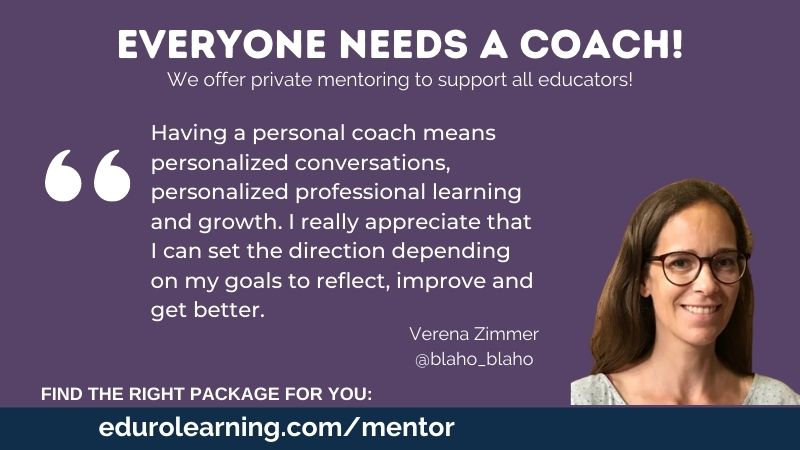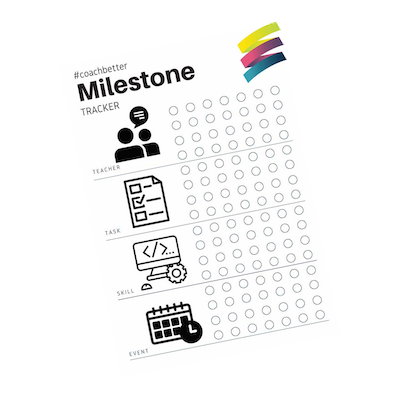Coaches are busy people! We have a lot to manage, among many competing priorities. Ironically, because our time is rarely scheduled for us (like a “normal” teacher schedule), we have to figure out how to get it all done on our own.
As coaches, our first priority is our coaching work, which in and of itself, is multi-faceted: coaching conversations, individual and team planning meetings, co-teaching or modeling in the classroom, reflection and evaluation, gathering data and looking at student work, leading professional learning, working with school leaders to implement change. And then, on top of all that, we’re also often teaching our own classes, or pulled into sub cover, extra duties or exam supervision. As one of my students in The Coach said, “only 10% of a coach’s job is visible, and there’s a lot more that goes into it than what you see”. Managing all of that, usually with very little support, can get really stressful.
Many of my students in The Coach and my private mentoring clients will often ask: how do you get it all done? If you’re a frequent reader or listener of the podcast, you’ll already know that I am super type-a, and being organized is totally my jam. So today I’m sharing five strategies that I think will help your productivity and your time management as an instructional coach.
1: Get it out of your head
Whatever it is you have to do, take it from your brain and put it somewhere else. It doesn’t matter what method you chose – it’s whatever works for you – whether it’s a pen and paper, or a digital service. I personally like to use my phone and I use the reminders app. The idea is to get yourself, to stop constantly thinking about the things you have to do know because you know that they’re recorded somewhere else. This allows you to “temporarily forget” about them until they actually need to happen.
I’m sharing this idea from the book, Getting Things Done, which talks about the fact that you are using up all your “daily memory space” (your RAM), thinking about the things you have to do, which doesn’t leave you much room to process anything else. This means you need a system for getting it out of your head so that you aren’t thinking about it constantly, but you know it’ll get done.
Another rule of thumb from GTD, is that if you have a thing that takes longer to write down than to actually do, just do it the thing right away. You get those little tasks out of the way, as soon as they happen, because it’s going to take you actually longer to think about doing them than it is to actually do them.
Most importantly (and this is something I’ve learned over time), when you are getting those ideas out of your brain and putting them in whatever format makes sense for you, set a deadline for completing that task. Your deadline could be half an hour from now, or this afternoon, or tomorrow, or a month from now that’s okay, but give yourself a timeline and slot it in where it fits into your schedule. This ensures that you have a time and a place to get this thing done.
Another important element is to schedule this task when you actually know you have time to complete it. I usually don’t add more than one “main” task for a day, three smaller, but significant tasks, and then as many little things as I can tick off (for satisfaction!). This helps me feel a positive sense of accomplishment each day, instead of having that endlessly growing to-do list. To do this, I will use my reminders app and set a day (and sometimes a time) to get each task done. This helps me feel confident that it’s actually possible for me to get those things done. Other people really like to put it into their calendar and actually schedule those things in specific times for each day. Use whatever works for you – it really doesn’t matter as long as it’s out of your brain and somewhere where you know it will be handled at the time that it needs to be handled.
Some other things to consider, is to schedule repeating tasks into your calendar, like a chunk of time to tackle & refresh your to-do list, or setting aside one hour to work on a big project each day over time, or scheduling 10 minutes after lunch for professional learning or connecting with your PLN on Twitter, whatever it might be. The goal here is to calendar this time in so that you’re not thinking about when you have to do it. It’s just part of your routine.
2: Break Projects into Manageable Steps
This tip is designed to help you avoid procrastination. Instead of thinking about a big task as getting everything done in “one” to do item, break down your projects into as many manageable steps as makes sense, and then calendar them in when it’s appropriate, when it fits into your schedule. It sounds trite, but it’s really true: once you start a project, it is so much easier to finish. Sometimes the key is just to trick yourself into getting started!
For example, this blog post & 5 Min Fri video: this doesn’t go into my Reminders app as one task, it goes in as:
- Brainstorm 5 Min Fri
- Record 5 Min Fri
- Create Canva card thumbnail
- Edit
- Upload & schedule 5 Min Fri
- Write & schedule 5 Min Fri blog post
- Write text for IG
- Create Canva cards for IG & Twitter
- Publish cards to social
So, instead of thinking of it as one “thing” (a published piece of content), I break it down into manageable steps, often on multiple days, and I tick them off as I do them. Every single time, once I do the first step, the second step seems so much easier.
If this process works for you, you could sort your tasks into the type they are high priority, regular or rotating, or future tasks, whatever fits best in terms of your workflow. You might also end up chunking tasks, so that the similar items are together. For example, I will often edit many 5 Min Fri videos on one day because once I’m in the flow, it’s very easy for me to get more than one done – often in just a little bit more time than it would take me to do just one. This works well for me because I like to look and plan ahead, others prefer to rotate tasks on a weekly basis so it becomes part of their regular workflow. Find what works for you and keep refining your process.
It’s important to remember that it is okay to say no, whether it’s to yourself in actually accomplishing something today or to someone else, because you’re just not going to be able to get that done today. It’s okay to look at something and say, this is not something that’s a priority right now. I cannot make it happen, either I’m never going to make it happen, or I can push it off to next week or tomorrow or next month or whatever seems right. I think about this as the 4 D’s: “do, delegate, delay, dump.” When I take the time to review my to do list, I can rank those tasks according to the 4Ds.
3: Create a Habit
It’s much easier to start something new than to change an existing habit. So instead of trying to stop yourself from doing something, try to start a new process, the easiest possible way and let it become a habit. This is referred to as “habit stacking” by James Clear in Atomic Habits. Whatever it is that you want to do, try to do it before something that you routinely do. This way you’re adding it into your every day routine, as opposed to stopping something.
In this case, you’re adding something that makes a difference in your productivity. When I think about creating a habit, I think about the importance of just getting started. There’s this concept of the infinite 1%, the biggest change is from doing nothing to doing something. So as soon as you start doing something, you’re making progress on whatever it is that you want to move forward on. This means, all you have to do is stop doing nothing and start doing something.
4: Just Start
Whatever kind of productivity process that you are thinking about doing, whether it’s something on your phone or in a journal or on a calendar on your computer, don’t worry about your system being perfect, just set something up and run with it. What’ll happen is that you’ll start accomplishing the tasks that you have written down somewhere else, and you’ll start using your new format for whatever the new tasks that come up for you. Over time, it will evolve and naturally become the thing that works for you. So just get started.
5: Start Small
Don’t try to get everything into your new system right away. Start with what you have and just add the new things that come up as you go along, keep it easy and let yourself be successful.
Free Download: Milestone Tracker
If those five tips were helpful for you, you will love our milestone tracker! It’s a little freebie to help you track those successful steps that you’ve taken in order to achieve those big milestones that you are working towards.
Watch the 5 Min Fri
Level Up Your Productivity with Private Mentoring
Mentorship can transform confusion into clarity, chaos to creativity, and stagnation into fresh skillsets.
If you are working on being more productive, you will love the opportunity to work with a mentor. Helping people feel productive, accomplished and satisfied at the end of the day (rather than overwhelmed and exhausted) is my jam! Over the past five years, I’ve worked with educators in a wide variety of positions from teacher to coach to school leader, and we always find ways to better leverage the time and energy we put into our responsibilities to move forward at a pace that feels just right for the individual.
We have a variety of private mentoring packages for you to chose from! We can work on any aspect of your professional growth: from productivity, to assessing and building a specific skillset, to managing difficult colleagues or conversations, to applying for a new job, and so much more! Private mentoring is completely customized to your needs! Check out the package options here, and reach out if you have questions. We’d love to work with you!



Recent Comments